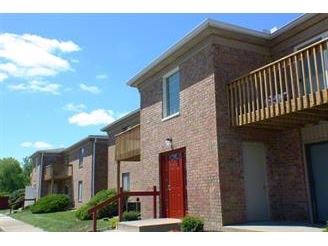Apartment investors and multifamily loan officers sometimes need to quickly value apartment buildings to see if an asking price or an apartment loan request is reasonable. The gross rent multiplier is not a perfectly accurate tool, but it's a quick, easy, and helpful one.
The Gross Rent Multiplier (GRM) is define as follows:
Gross Rent Multiplier = Sales Price / Annual Gross Scheduled Rents
For example, let's suppose a 12-unit apartment building sold for $1,350,000. All 12 apartment units were 2-bedroom, 1-bath units rented for $1,000 per month. Twelve-thousand dollars per month times twelve months equals $144,000 in annual gross scheduled rents. Therefore we have:
Gross Rent Multiplier = $1,350,000 / $144,000
GRM = 9.4
 Let's look at another example, but this time let's use the gross rent multiplier to compute the likely sales price or value of an apartment building. Suppose we're now looking at a 10-unit apartment building located just a few blocks away from the 12-plex (the above example) that sold last week for $1,350,000. We calculated the gross rent multiplier on the 12-plex to be 9.4, and let's assume the two buildings are roughly comparable (same neighborhood, similar condition, similar appeal).
Let's look at another example, but this time let's use the gross rent multiplier to compute the likely sales price or value of an apartment building. Suppose we're now looking at a 10-unit apartment building located just a few blocks away from the 12-plex (the above example) that sold last week for $1,350,000. We calculated the gross rent multiplier on the 12-plex to be 9.4, and let's assume the two buildings are roughly comparable (same neighborhood, similar condition, similar appeal).
So what is the 10-plex worth if its annual gross scheduled rents are $118,600? This one is pretty simple. What do you do with a gross rent multiplier? Er .... multiply the gross rents by it? Correcto-mundo!
Sales Price* = Annual Gross Scheduled Rents x Gross Rent Multiplier
*or Value
Value = $118,600 x 9.4
Value of the 10-Plex = $1,115,000
The nice thing about the gross rent multiplier is that the comparable apartment buildings don't have to be all that similar. If one apartment building is nicer than another, its really not a problem. The adjustment is automatically built in because the nicer building will command a higher rent. In other words, Building A is nicer and rents for $0.76 per square foot per month, while Building B is more run down and rents for only $0.63 per month per square foot. The same gross rent multiplier can be used to value both apartment buildings. Investors buy apartment buildings to generate income. The valuation of Building A - the nicer building - will come in appropriately higher than Building B because Building A commands a higher rent.
So how do apartment investors and multifamily loan officers arrive at the proper gross rent multiplier for an apartment building? They look at the sales of other apartments in the neighborhood. Then they divide the sales price by the property's annual gross scheduled rents to arrive at the gross rent multiplier. After computing the GRM for a dozen or so apartment sales in a town or large city neighborhood, apartment investors and apartment loan officers start to get a good feel for the value of a multifamily property.
Marcus and Millichap is nationally known brokerage firm that is particularly good at selling apartment buildings. An easy way to get an approximate gross rent multiplier would be to simply call a local Marcus & Millichap broker and ask him. He'll know.
Let's suppose you're a commercial loan officer for a bank, working in the multifamily lending department. A newby real estate broker brings you an apartment loan request for a $2,700,000 refinance on a 20-unit apartment building. The borrower is refinancing his building to pull out equity to buy a second building. The whole deal only makes sense if the borrower can borrow the full $2,700,000. An apartment loan of $2,500,000 simply won't suffice.
"So how much is his current apartment building worth?" you ask the newby. "I dunno. I just started in the business," he replies. "Okay, then what is the apartment building's annual gross scheduled rents?" you ask. The newbie replies, $257,000."
From working on other apartment deals, you know that apartments in Fishers, Indiana sell for a gross rent multiplier of around 11.0. You therefore multiply $257,000 by 11.0 (the GRM) to arrive at a value of just $2,820,000. Uh-oh, the deal doesn't make sense. There is no way that your commercial bank is going to make a loan of $2,700,000 on an apartment building worth only $2,820,000. That would be an insane loan-to-value ratio of 95.7%! (Seventy-five percent LTV would be more reasonable on an "A" deal.) So you quickly kill the deal and move on to the do-able deals on your desk.
So what is the proper gross rent multiplier for apartments in Fishers, Indiana or Sacramento, California. The answer is that each area has its own number. Gross rent multipliers can range as low as 4.5 in the flatlands of Oakland or the South side of Chicago (gang territory) to as high as 12 to 13 in the ritzy neighborhoods of Palo Alto or San Francisco.
A lot depends on the availabilty of nearby land for development. If you are looking to make an apartment loan in Indianapolis or suburban Dallas, where there are still plenty of in-fill lots available, where developers could build competing apartment buildings, rents are unlikely to soar. Why? Because if rents did soar, some developer would quickly rush in and throw up a competing apartment building.
On the other hand, if the subject apartment building is located in downtown San Francisco, where hardly one square inch is undeveloped, you could envision apartment rents soaring further, if, say, Twitter relocated its headquarters to downtown San Francisco. (This is true, by the way.) The more likely that apartment rents will increase in the future, the higher the gross rent multiplier that investors will pay.
Earlier I mentioned that the comparable apartment buildings do NOT have to be terribly similar. For example, its perfectly acceptable to use the gross rent multiplier, derived from the sale of an apartment building with all one-bedroom units, to value an apartment building with all two-bedroom units. How can this be? The building with two-bedroom units will command higher rents, and those higher rents will produce a higher valuation.
However, when computing and using a gross rent multiplier, be sure to use apartment buildings with similar operating expenses.
Here's why: In the downtown area of many big cities, there are many older apartment buildings that are not individually-metered for utilities. There the landlord pays all of the utilities. The rents for these apartments will be $350 per month, or so, more expensive than individually-metered apartment units because the landlord needs the extra dough to pay the utilities. You cannot compare apples to oranges.
The gross rent multiplier is far from a perfect valuation tool for other reasons as well. The gross rent multiplier does not take into consideration any vacancies that the area may be suffering. Instead, it uses gross scheduled rents, as if every unit were occupied. Therefore, in areas of high apartment vacancies (think of the lower-income areas of St. Louis), the gross rent multiplier will be significantly lower.
Collection loss is another issue. If a large percentage of tenants fail to pay their rents (think of the outlying areas of Houston), the gross rent multiplier will be pitifully low.
Gross rent multipliers are the opposite of cap rates. Very desirable apartment buildings in nice, very dense areas sell for high GRM's; while low-income apartment buildings in war zones sell at shockingly low GRM's.






